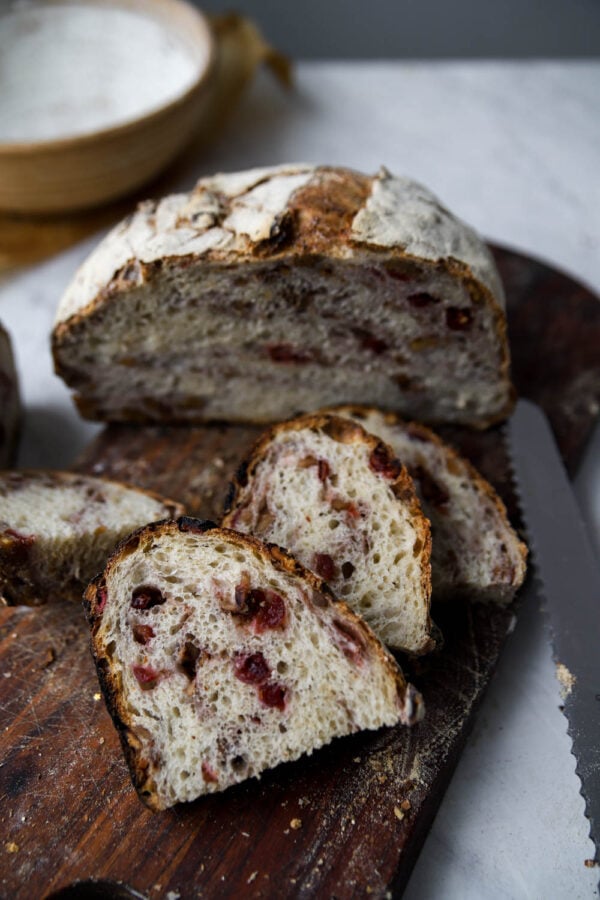
One of the best things about making your own bread at home, is having the freedom to customize each loaf to your taste. Adding mix-ins to your homemade sourdough bread or everyday artisan loaves is an amazing way to get creative on your bread making journey. By now, you all know that baking (and baking bread especially) is chemistry, so before tossing in anything, here are a few rules about how each addition will affect the final loaf.
Before I get in to the mix-ins, let’s talk about how to physically work these inclusions into your dough. There are several different methods, but my favorite way to to incorporate mix-ins is by dimpling them in after the dough has autolysed. After mixing up the dough, it’s really important to let the flour absorb the water, which helps strengthen the gluten.
Why do we care about strong gluten? The gluten strength is what holds our bread up, essentially. Strong gluten will keep our crumb airy, and allows us to keep our mix-ins suspended evenly throughout the dough (without sinking to the bottom). If you add the mix-ins too early, they will essentially cut up the gluten strands of the dough. Just remember, mix and autolyse first, then add mix-ins.
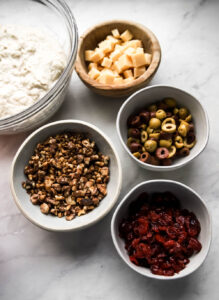
How to actually add mix-ins to your bread?
I like to pour the mix-ins, let’s say roasted walnuts and cranberries on top of the autolysed dough. Then, using my fingertips, I press them down into the surface of the dough. Think of dimpling the surface of a focaccia. It’s a really sensory process, and it’s really fun to get kids involved at this stage as well. Continue to press and dimple them in until there are no loose mix-ins.
I then let the dough rest for about 15-20 minutes at room temperature, covered. After the rest period, I stretch and fold the dough, but lifting one side of the dough up as far as it will stretch without tearing, and folding it over the ball of dough. Work your way around the perimeter of the whole dough ball.
Cover the dough, let rest for 20 minutes, the stretch and fold again. Two to three stretches and folds should be plenty to thoroughly incorporate the mix-ins.
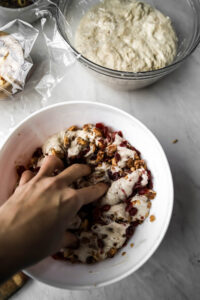
How much should you add?
There’s is definitely such a thing as too much of a good. If you add too many mix-ins, they will weigh down your bread. Also, the flavors won’t be balanced. I generally go for about 1 cup or 100 grams of each mix in, and I think 1 to 2 different inclusions per loaf is plenty. More than that can be overwhelming.
How to slash and bake rustic bread with mix-ins?
Before baking bread, I almost always slash, or score, the top of the loaf to allow the internal steam to escape. Usually I just do a simply slit down the middle using a very sharp knife or a lame, but you can absolutely get creative with intricate patterns. The sky is the limit here! Pro Tip: If you want your design to really pop, dust the top surface of your loaf with flour, then score. The bread will open where you’ve cut, and bake up more brown, contrasting the white of the flour.
It’s really important to bake your bread with steam in the oven. What do I mean? Either bake your loaf in a closed Dutch oven (like this one), or on a heated baking stone with a pan of water in the bottom of the oven to create steam. The steam keeps the outer crust of the bread soft, which allows the bread to rise to it’s fullest potential without worrying the crust will harden too quickly. About halfway through the baking time, I remove the lid of the Dutch oven (after the bread has fully rise in the oven) to then allow the crust to brown properly.
Dried Fruit
Some of the most common bread mix-ins are dried fruits like cranberries, apricots, raisins, and currants. Since these mix-ins are dried, they naturally absorb water. If we added them straight into the dough, they would absorb a significant amount of our dough’s water, and would affect the final results.
Instead, I soak them in warm water for about 30 minutes prior to adding them to the dough. After the soak, drain the dried fruit, then dimple them into the dough after the autolyse. Note: some dried fruits are “drier” than others. Use your judgement here. If the fruit is still very hard and chewy after the 30-minute soak, let them soak for longer until the fruit is hydrated and chewy.
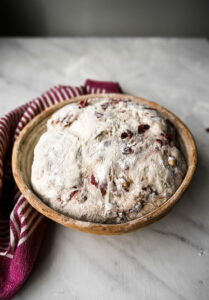
Nuts + Seeds
Walnuts, pecan, chia, flax, sunflower seeds! The options are truly endless, and that is a beautiful thing! When it comes to adding nuts to bread, i love to roast the nuts first to really enhance their flavor and natural nuttiness. This is totally a personal preference, but if you choose to go that route, roast the nuts in a 350 degree on a sheet pan for about 10-12 minutes until they’re golden and fragrant. I like to roughly chop the nuts, which just makes it easily to incorporate into the dough, as well as slicing later.
For seeds, and harder nuts like almonds, I definitely recommend soaking them in warm water for at least an hour (or 2 if you remember!) before adding them into your bread dough. Just like dried fruit, I soak them, strain them, then dimple them into the dough after the autolyse.
Cheese
Depending on the type of cheese, I like to either grate or do a fine dice. Some of my favorite cheese mix-ins are mild and sharp cheddar, provolone, asiago, parmesan, Jarlsberg. You can be really creative here. If you’re using a harder cheese like parmesan, it’s best to grate it. For a softer cheese like provolone, go with a small dice about 1/2-inch.
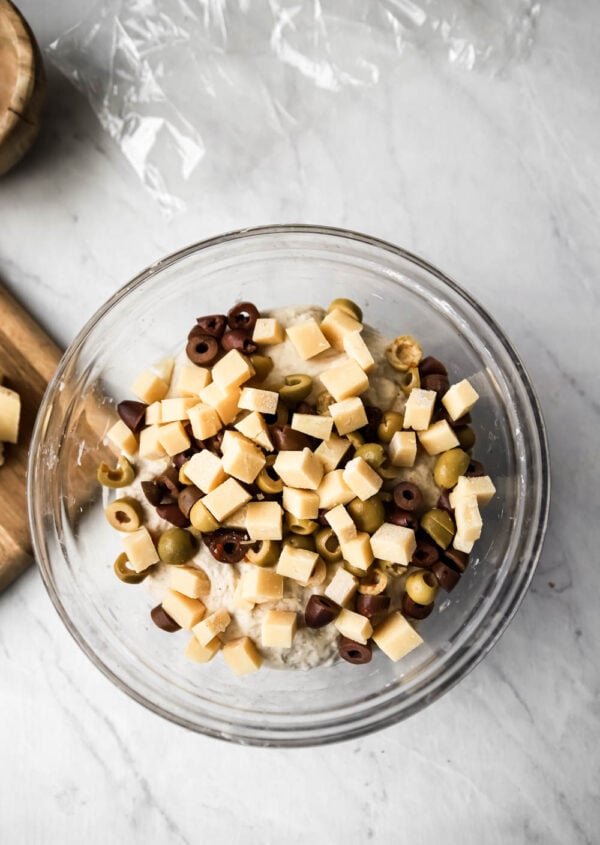
Olives + Alliums
One of my absolute favorite mix-ins are olives! The added saltiness and briny flavor are so good. That being said, olives are usually sold in a salt brine that can be kind of overwhelming. Before adding olives to my dough, I give them a quick rinse to remove some of the extra brine. This prevents the bread from being overly salty.
Sometimes olives are stored in oily brine, and that added oil actually works well with bread dough. So, a light rinse will suffice, don’t go crazy. It’s a good idea to chop up the olives before incorporating them in your dough. First, you want to ensure that there are no hidden pits or pit pieces. Second, the bread will slice nicer.
Finally, roasted garlic is another popular mix-in. As mentioned above, it is possible to have too much a good thing. Garlic is a very prominent flavor. A little goes a long way, so think about adding about 1/4 – 1/2 cup total to each loaf. Give the cloves a rough chop before dimpling them into the dough. This probably goes without saying, but there’s no need to rinse the garlic. In fact, if it was roasted in oil, it’s fine for a bit of oil to be added to enrich the dough as well.
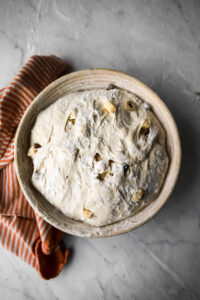
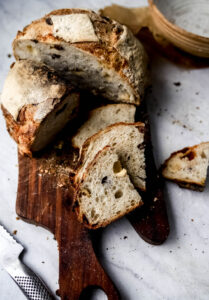
I really hope this guide is helpful to you! What are some of your favorite mix-ins? After reading this, what are you planning to experiment with?
Leave a comment below and let me know what you’re going to add to your sourdough.
happy baking! – LeAnne
The post ‘How to add mix-ins to bread’ first appeared on Lion’s Bread Blog


:D says
How would you add in the mix-ins on your Lazy Girl Sourdough bread with only 1 S/F?
LeAnne says
I would do this after the autolyse, then just add another stretch and fold, no big deal 🙂